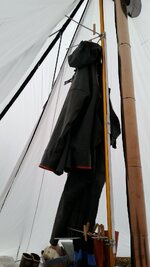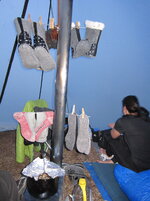Let me add some comments I made on another thread that may help guys decide on a shelter.
After running tipis for about 15 years....along with a few other tents- I almost made myself a smaller version of my 12" diameter tipi in DCF....but ended up with a Tarptent Double Rainbow and glad I did.
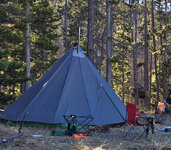
Here's my homemade tipi on a Montana hunt- a cold morning sagging about the max. If you have ever seen the commercial tipis with bigger panels in cold weather you know- those sag way more than this.
Tipis work best when they are tight. They shed the wind better than any other shelter- when tight...but when sagging the wind can catch in them and potentially topple the thing.Seek Outside did a good test on their stuff in the snow on their website which illustrates the sag I'm talking about if you haven't seen it.
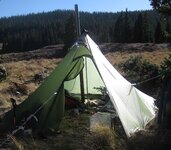
My old Golite tipi ^ was a sagging monster with those big open panels. Here's a rare pic of it taught. I was constantly adjusting those. Plus, the fabric was crap [I think it was 15 denier] and the way the walls swooped down close to the ground not only cut the space by 1/3rd, but condensation was getting all over everything close to the perimeter. This design would benefit greatly made from DCF.
I was on the Alaska peninsula with a buddy on a drop camp for moose and one night we had verified 60 mph plus winds in my homemade tipi in the first pic. I got up and tightened the lines and it went from flapping to barely moving rock solid. You wouldn't believe the difference- it was like being in a concrete bunker.
It's worth mentioning, my tipi doesn't sag as bad as the same size Kifaru tipi-by design- for 2 reasons. I used more seams- it's 10 panels vs the 8 panels others use- so smaller panels....and I used a slightly heavier 1.6oz sil poly vs the 1.1 oz stuff the commercial ones are made from. Smaller panels gives it less shrink...and more seams adds strength. plus I rolled those seams with one more fold than the commercial ones- super strong but a little heavier.
The big panels on the tipis like that Golite...or something like the SO Cimmaron or the Kifaru Sawtooth will sag a lot...and DCF will be much better in those designs.
That said, my tipi [7 1/2' tall, 12 1/2' in diameter] still sags a little when cold. making it from DCF would have been expensive.
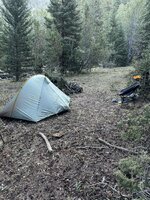
Here the DR is a little bit distorted due to stuff stacked under the vestibule
The design of my Tarptent Double rainbow is pretty ingenious. It's 1.1oz sil nylon. The hoop design with one long pole keeps it taught with almost no sag. There can be a tiny bit of sag on the outward panels of fabric- but it's not much- incredible design that doesn't benefit much by using DCF....where the center pole tipis and tent designs would benefit.
Just some thoughts from using these tents and tipis for 4 decades in a lot of varying conditions...including one trip to Kodiak with 90mph winds one night that broke poles on my Cabelas Alaskan tent.




